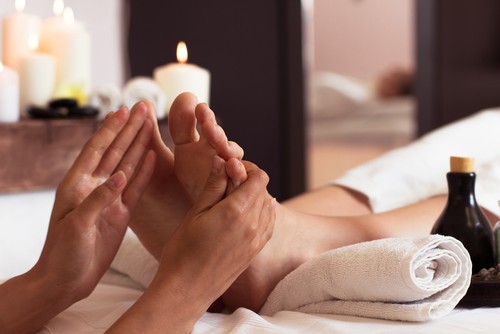A foot massage can be very relaxing and beneficial. But how often should you get one?
Regular foot massages can improve your overall well-being. They help with stress relief, better sleep, and improved circulation. Many people wonder how often they need to schedule a foot massage to enjoy these benefits. The answer depends on your lifestyle, health, and personal needs.
In this blog post, we will explore how often you should get a foot massage. We’ll look at the factors that influence this frequency and help you decide what works best for you. Whether you’re dealing with chronic pain, stress, or just want to pamper yourself, understanding the right frequency can make a big difference. Let’s dive in and find the perfect balance for you.
Benefits Of Foot Massages
Foot massages offer a range of benefits that can improve your overall well-being. Regular foot massages can enhance physical and mental health. They are a simple way to care for your body. Here are some key benefits of foot massages.
Improved Circulation
Foot massages can boost blood flow. Better circulation means more oxygen and nutrients reach your cells. This can lead to healthier tissues and quicker recovery from injuries. Good circulation also helps to prevent swelling and discomfort in your feet.
Stress Relief
Foot massages can help you relax. They reduce stress and promote a sense of calm. The act of massaging your feet can release tension in your muscles. This can lead to a better mood and improved mental clarity. Stress relief through foot massages can even improve your sleep quality.
Pain Management
Foot massages can ease pain in your feet and lower legs. They can help with conditions like plantar fasciitis or arthritis. Massaging your feet can also reduce the discomfort of sore muscles. Regular foot massages can decrease chronic pain over time.
Factors Influencing Frequency
How often should you get a foot massage? The answer depends on several factors. Understanding these can help you decide the best frequency for you.
Lifestyle And Activity Level
Your daily activities play a big role. If you are active, your feet work hard. They need regular care. Athletes or those who stand a lot need more frequent massages.
On the other hand, if you have a sedentary lifestyle, you might not need massages as often. But, sitting too much can cause foot issues. Regular massages can still be beneficial.
Health Conditions
Health conditions affect how often you need a foot massage. Conditions like diabetes, arthritis, or plantar fasciitis may require more frequent sessions. Regular massages can help manage pain and improve circulation.
If you have no specific health issues, you might not need massages as often. But always listen to your body. If you feel discomfort, a massage can help.
Personal Preferences
Your personal preferences matter too. Some people love massages and find them relaxing. If you enjoy them, you might want them more often.
Others might prefer less frequent sessions. It is important to find what works best for you. Your comfort and enjoyment are key.
General Recommendations
Foot massages offer numerous benefits, from pain relief to stress reduction. How often you should get a foot massage depends on your needs and lifestyle. Here are some general recommendations to help you decide the best frequency for you.
Weekly Sessions
Getting a foot massage once a week can be very beneficial. This frequency is ideal for those with chronic pain or high-stress levels. Weekly sessions help in maintaining muscle flexibility and improving blood flow. They also aid in reducing anxiety and enhancing overall well-being.
Regular weekly massages can be a great way to unwind after a hectic week. They can also help in preventing injuries by keeping your feet relaxed and less prone to strains.
Bi-weekly Sessions
Bi-weekly foot massages are suitable for individuals with moderate stress or minor aches. Scheduling a massage every two weeks helps in managing stress and maintaining muscle health. This frequency is a balanced approach that provides consistent relief without taking too much time from your schedule.
Bi-weekly sessions can also help in improving your sleep patterns. They can provide a much-needed break and rejuvenation, making you feel refreshed and more energetic.
Monthly Sessions
Monthly foot massages can be a good option for those who have minimal foot issues. This frequency is great for general maintenance and relaxation. Monthly sessions help in keeping your feet healthy and can serve as a preventive measure against potential issues.
These sessions can also be a treat for yourself. They can be a part of your self-care routine, helping you to unwind and recharge.
Signs You Need A Foot Massage
Our feet often bear the brunt of our daily activities. They carry our weight and get us where we need to go. A foot massage can provide relief and comfort. But how do you know when it’s time for one? Here are some signs that you might need a foot massage.
Chronic Pain
Chronic pain in your feet is a clear sign. This pain can be dull or sharp. It can be constant or come and go. If walking or standing becomes unbearable, a foot massage may help. Regular massages can reduce pain and improve your quality of life.
Swelling
Swelling in the feet is common. It can happen after a long day of standing or walking. Swelling can also occur from sitting for long periods. A foot massage helps reduce swelling and promotes better circulation. Massages can ease discomfort and make your feet feel lighter.
Fatigue
Fatigue in your feet can be draining. It can make you feel tired and sluggish. If your feet feel heavy and worn out, a foot massage can help. Massages boost energy levels and relieve stress. They make your feet feel refreshed and rejuvenated.
When To Avoid Foot Massages
Foot massages can be incredibly relaxing and beneficial for overall health. Yet, there are times when you should avoid them. Understanding these situations ensures your safety and well-being.
Injuries
Foot massages can worsen certain injuries. If you have a sprain, fracture, or any serious injury, avoid foot massages. Massaging can increase pain and delay healing. Always consult a doctor before resuming massages.
Infections
Foot infections require immediate medical attention. Massaging an infected foot can spread the infection. Avoid massages until the infection is completely healed. This includes fungal infections like athlete’s foot.
Pregnancy Considerations
Pregnancy requires special care. Some pressure points in the feet can trigger contractions. Avoid foot massages during the first trimester. Always consult your healthcare provider about massages. They can guide you on safe practices.

Credit: www.aiam.edu
Types Of Foot Massages
Experiencing regular foot massages can bring a plethora of health benefits. Knowing the different types of foot massages available can help you choose the best one. Let’s explore some popular options.
Swedish Massage
The Swedish massage is gentle and relaxing. It uses long, smooth strokes to ease muscle tension and improve circulation. This type is perfect for those new to massages or seeking a soothing experience.
Deep Tissue Massage
Deep tissue massage targets deeper muscle layers. It involves slow, firm strokes to alleviate chronic pain and muscle knots. This type is ideal for athletes or those with persistent foot pain.
Reflexology
Reflexology focuses on specific points on the feet. It is believed that these points correspond to different body organs and systems. Reflexology can help improve overall health and reduce stress.
Diy Foot Massage Techniques
Do you love the feeling of a foot massage but can’t always make it to a professional? You can enjoy the benefits of a foot massage in the comfort of your own home. Let’s explore some DIY foot massage techniques that can help you feel relaxed and rejuvenated.
Using Massage Tools
Massage tools can enhance your DIY foot massage experience. Here are some options:
- Foot rollers: Roll your feet over these to relieve tension.
- Massage balls: Use these to target specific pressure points.
- Electric massagers: These can provide a deeper massage.
Self-massage Steps
Follow these simple steps for a relaxing self-massage:
- Soak your feet in warm water for 10 minutes. This relaxes your muscles.
- Apply lotion or oil to your feet. This helps your hands glide smoothly.
- Use your thumbs to apply pressure to the arch of your foot. Move in circular motions.
- Massage your heel and toes using your fingers. Focus on any sore spots.
- Finish by massaging your ankles and the top of your feet.
Benefits Of Essential Oils
Adding essential oils can enhance your foot massage. Here are some benefits:
| Essential Oil | Benefit |
|---|---|
| Lavender | Promotes relaxation and reduces stress. |
| Peppermint | Cools and refreshes tired feet. |
| Eucalyptus | Reduces pain and inflammation. |
Just add a few drops to your lotion or oil for an enhanced experience.

Credit: redfernentus.com
Finding A Professional
Getting a foot massage can help with relaxation and pain relief. But finding the right professional is key. A skilled therapist can make a big difference in your experience. Below are some tips to help you find the right therapist.
Choosing A Therapist
Start by checking online reviews. Look for therapists with high ratings and positive feedback. Ask friends or family for recommendations. They might know a good therapist.
Visit the therapist’s website. Check their qualifications and experience. Make sure they have the right training and certifications. A professional therapist should be licensed.
What To Expect
Your first visit will include a consultation. The therapist will ask about your health and any specific issues. Be honest about your needs and concerns.
The massage session will usually last between 30 to 60 minutes. The therapist will use different techniques to relieve tension. You should feel relaxed and comfortable throughout the session.
Cost Considerations
The cost of a foot massage can vary. Prices depend on the therapist’s experience and location. Here is a simple table to give you an idea:
| Therapist Level | Session Cost |
|---|---|
| Beginner | $30 – $50 |
| Intermediate | $50 – $70 |
| Expert | $70 – $100 |
Check if the therapist offers package deals. You might save money by booking multiple sessions. Some therapists also offer discounts for first-time clients.

Credit: www.purewow.com
Frequently Asked Questions
How Often Is Foot Massage Recommended?
Foot massage is generally recommended once a week. This frequency helps in maintaining relaxation and improving circulation.
Are Foot Massages Good For Health?
Yes, foot massages are beneficial for health. They improve blood circulation, reduce stress, and relieve foot pain.
How Long Should A Foot Massage Last?
A typical foot massage should last between 30 to 60 minutes. This duration ensures adequate relaxation and therapeutic benefits.
Can Foot Massage Improve Sleep?
Yes, foot massages can improve sleep. They promote relaxation and reduce stress, helping you sleep better.
Conclusion
Regular foot massages can improve your overall well-being. They help with relaxation, stress relief, and better circulation. Aim for a weekly session for the best results. Listen to your body and adjust as needed. Consistent massages lead to happier, healthier feet.
Treat yourself and enjoy the benefits of foot care. Remember, your feet deserve attention too. So, schedule your next foot massage soon. Experience the positive effects firsthand. Feel better, step by step.



